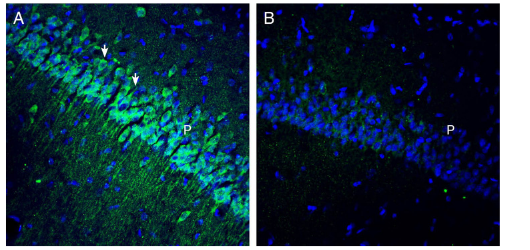Overview
- Peptide (C)EQMQKVRGFR(S)GKKS, corresponding to amino acid residues 522 - 536 of mouse OCTN1 (Accession Q9Z306). Intracellular, C-terminus.

 Western blot analysis of mouse kidney lysates (lanes 1 and 3) and rat small intestine lysates (lanes 2 and 4):1-2. Anti-OCTN1/SLC22A4 Antibody (#ACT-014), (1:200).
Western blot analysis of mouse kidney lysates (lanes 1 and 3) and rat small intestine lysates (lanes 2 and 4):1-2. Anti-OCTN1/SLC22A4 Antibody (#ACT-014), (1:200).
3-4. Anti-OCTN1/SLC22A4 Antibody, preincubated with
OCTN1/SLC22A4 Antibody Blocking Peptide (BLP-CT014). Western blot analysis of mouse brain membranes (lanes 1 and 3) and rat brain membranes (lanes 2 and 4):1-2. Anti-OCTN1/SLC22A4 Antibody (#ACT-014), (1:600).
Western blot analysis of mouse brain membranes (lanes 1 and 3) and rat brain membranes (lanes 2 and 4):1-2. Anti-OCTN1/SLC22A4 Antibody (#ACT-014), (1:600).
3-4. Anti-OCTN1/SLC22A4 Antibody, preincubated with
OCTN1/SLC22A4 Antibody Blocking Peptide (BLP-CT014). Western blot analysis of human THP-1 monocytic leukemia cell line lysates (lanes 1 and 4), mouse BV-2 microglia cell line lysates (lanes 2 and 5) and human HeLa cervix adenocarcinoma cell line lysates (lanes 3 and 6):1-3. Anti-OCTN1/SLC22A4 Antibody (#ACT-014), (1:400).
Western blot analysis of human THP-1 monocytic leukemia cell line lysates (lanes 1 and 4), mouse BV-2 microglia cell line lysates (lanes 2 and 5) and human HeLa cervix adenocarcinoma cell line lysates (lanes 3 and 6):1-3. Anti-OCTN1/SLC22A4 Antibody (#ACT-014), (1:400).
4-6. Anti-OCTN1/SLC22A4 Antibody, preincubated with
OCTN1/SLC22A4 Antibody Blocking Peptide (BLP-CT014).
 Expression of OCTN1 in rat hippocampus.Immunohistochemical staining of perfusion-fixed frozen mouse brain sections with Anti-OCTN1/SLC22A4 Antibody (#ACT-014), (1:1200), followed by goat anti-rabbit-AlexaFluor-488. A. OCTN1 immunoreactivity (green) appears in neuronal profiles in the pyramidal layer (P, arrows). B. Pre-incubation of the antibody with OCTN1/SLC22A4 Antibody Blocking Peptide (BLP-CT014), suppressed staining. Cell nuclei are stained with DAPI (blue).
Expression of OCTN1 in rat hippocampus.Immunohistochemical staining of perfusion-fixed frozen mouse brain sections with Anti-OCTN1/SLC22A4 Antibody (#ACT-014), (1:1200), followed by goat anti-rabbit-AlexaFluor-488. A. OCTN1 immunoreactivity (green) appears in neuronal profiles in the pyramidal layer (P, arrows). B. Pre-incubation of the antibody with OCTN1/SLC22A4 Antibody Blocking Peptide (BLP-CT014), suppressed staining. Cell nuclei are stained with DAPI (blue).
- Nakamichi, N. et al (2017) Biol. Pharm. Bull, 40, 1146.
- Pochini, L. et al (2019) SLAS Discov, 24, 89.
- Grundemann, D. et al (2005) PNAS, 102, 5256.
Organic Cation Transporter Novel (OCTN) is a subfamily of the larger Organic Cation Transporter (OCT) or SLC22 transporter family.
The OCTN subfamily consists of two members in humans: OCTN1 (SLC22A4) and OCTN2 (SLC22A5) with a third member (SLC22A21) present only in rodents 1-2.
The physiological role of OCTN1 (SLC22A4) has not yet been elucidated. OCTN1 is ubiquitously expressed throughout the body and transports various therapeutic agents, including organic cations and zwitterions. Ergothioneine (ET/ ERGO) a natural diet-derived antioxidant was found to be a specific substrate of OCTN1 3.
OCTN1 is functionally expressed in neurons and neural stem cells and activation of the transporter could conceivably have a protective role in neurodegenerative diseases. In addition, in peripheral organs, mutations in OCTN1 are associated with susceptibility to Crohn’s disease and rheumatoid arthritis suggesting that OCTN1 may play a role in inflammatory dieseases 1.
Application key:
Species reactivity key:
Anti-OCTN1/SLC22A4 Antibody (#ACT-014) is a highly specific antibody directed against an epitope of the mouse protein. The antibody can be used in western blot and immunohistochemistry applications. It has been designed to recognize OCTN1 from mouse, rat and human samples.
